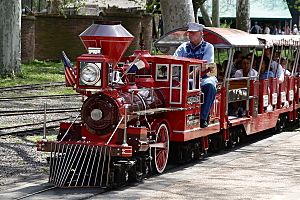C. P. Huntington facts for kids
Quick facts for kids C. P. Huntington |
|
 |
|
| C. P. Huntington after its 1888 rebuild in Sacramento | |
| Power type | Steam |
|---|---|
| Builder | Cooke Locomotive Works |
| Serial number | 277 |
| Build date | October 1863 |
| Configuration | 4-2-4T |
| UIC classification | 2′A2′ nt |
| Gauge | 4 ft 8 1⁄2 in (1,435 mm) standard gauge |
| Driver diameter | 54 in (1,372 mm) |
| Weight on drivers | 18,500 lb (8,400 kilograms; 8.4 metric tons) |
| Locomotive weight | 39,000 lb (18,000 kilograms; 18 metric tons) |
| Boiler pressure | 125 lbf/in2 (862 kPa) |
| Cylinders | Two, outside |
| Cylinder size | 11 in × 15 in (279 mm × 381 mm) |
| Valve gear | (?) |
| Valve type | Slide valves |
| Tractive effort | 3,571 lbf (15.88 kN) |
| Official name | C. P. Huntington |
| First run | April 15, 1864 |
| Retired | 1914 |
| Current owner | California State Railroad Museum |
| Disposition | Static display |
C. P. Huntington is a special steam locomotive that you can see today at the California State Railroad Museum in Sacramento, California, USA. It is a type of train called a 4-2-4T locomotive. This train was the very first one bought by the Southern Pacific Railroad, and it carried their number 1. The locomotive is named after Collis P. Huntington, who was an important leader of the Southern Pacific Company.
Contents
History of the C. P. Huntington
The Start of a Journey
The C. P. Huntington was first bought by the Central Pacific Railroad (CP) in 1863. It was CP's third locomotive, following Gov. Stanford and Pacific. The train began its work on April 15, 1864. It helped build the western part of the First Transcontinental Railroad in North America. This was a huge project that connected the east and west coasts of the United States by rail.
New Owners and Rebuilds
The Southern Pacific (SP) bought C. P. Huntington from Central Pacific on February 5, 1871. They gave it their number 1. The train was used for lighter jobs in northern California. It was updated twice to keep it running well.
- In 1873, it received new valves.
- In 1888, it got a brand new boiler from CP's shops in Sacramento.
That same year, the locomotive was shown to the public for the first time in Sacramento.
Changes and Displays
In 1891, Southern Pacific changed its numbering system, and C. P. Huntington became number 1001. The train was stored for a while. In 1901, it was rebuilt to try and burn weeds along the tracks. However, this job did not work out well, so the train was taken out of service again.
In 1910, C. P. Huntington was rebuilt once more. It then stayed at SP's machine shops for a few years. The train was almost scrapped (taken apart for its materials) in 1914. Luckily, Southern Pacific management saved it. They wanted it to be displayed at the Panama–Pacific International Exposition in 1915. Before the display, it received a cosmetic restoration to make it look good.
A Special Appearance
On May 3, 1939, C. P. Huntington took part in a big event. It helped open the Los Angeles Union Station. The Huntington ran on its own steam, parading past cheering crowds. Other famous trains were also there, like the Inyo and a large Southern Pacific 4120. A famous animator named Ward Kimball, who loved trains, filmed this moment. This might be the only known video of the C. P. Huntington running under its own steam.
Its Final Home
Southern Pacific gave the C. P. Huntington to the State of California in 1964. It was first displayed at the old state fairgrounds in Sacramento. In 1970, it was refurbished again at Southern Pacific's Sacramento Shops. Then, in 1979, it was moved to the Central Pacific Railroad Passenger Station in Old Sacramento. Finally, in 1981, it moved into the new California State Railroad Museum. This is where it stays today, on static display for everyone to see.
Working Replicas

Did you know there are many smaller versions of the C. P. Huntington? A company called Chance Rides started making these smaller, narrow gauge trains in 1960. These trains are often found in amusement parks and zoos.
- Since 2018, these replica trains can run on gasoline, diesel, propane, or electricity.
- They have an automatic system that sends power to the wheels.
- The large front wheels you see on these replicas don't actually power the train. They just roll along the tracks. The real power comes from inside the train.
More than 400 of these C. P. Huntington replicas have been built as of 2022. They are very popular park trains because they are easier to take care of and operate than real steam locomotives. Many parks choose these replicas because they can be customized with different colors and designs.
Another company in California, Western Train Co., also makes replicas of the C. P. Huntington. They can even change older C. P. Huntington trains to run on diesel power.
In Popular Culture
The special look of the C. P. Huntington train helped inspire the way The Little Engine That Could looks in most storybooks.

